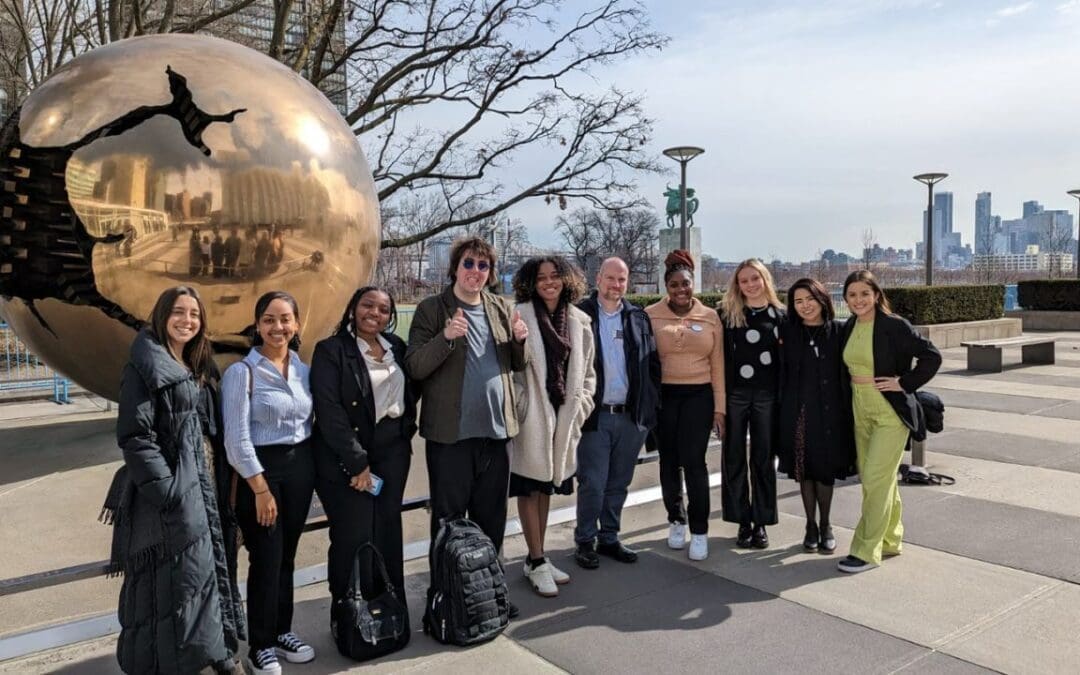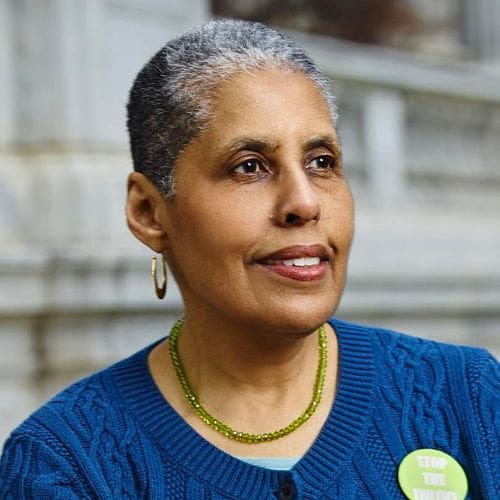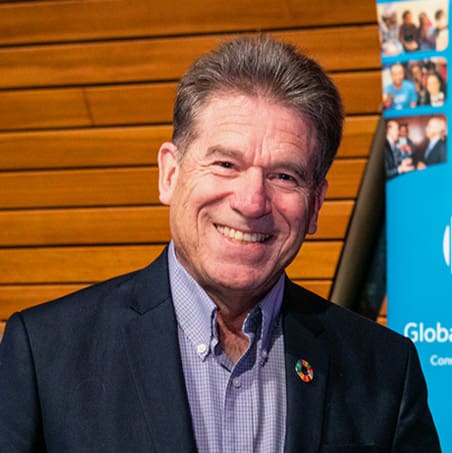
by Marina Jiménez Melgosa | Mar 30, 2023 | Global Cooperation, United Nations
Being invited to the first Global Future Forum in New York City from March 20-22 was something I never imagined when I arrived in the United States seven months ago. My name is Marina Jiménez, and I am a fourth-year Law and Political student from Universidad Carlos III de Madrid, Spain. Last September, I came to the United States to study for a year at Northeastern University (Boston) and, I was given an opportunity to be sponsored by Citizens for Global Solutions to not just to be part of the first Global Future Forum but to present my research paper, “Open Door opportunities that leave many young people on the doorstep” about the exploitative unpaid internships in the United Nations (UN) at the Youth Pavilion..
But first things first. What was the Global Futures Forum? The Global Futures Forum (GFF) was a two-day event celebrated in New York to conclude several months of work on the “People’s Pact for the Future”, a document that encapsulates several proposals made by civil society about the UN’s future and the reforms that must be made, as an attempt to not only be heard but be presented at the Summit of the Future in 2024. During the previous weeks, Coalition For the UN We Need (C4UN) and the Stimson Center– the coalition that made it all possible; coordinated different E-consultations related to seven tracks: Peace and Security, Human Rights and Participation, UN and Global Governance and Innovation, Global Economic and Financial Architecture, Environmental Governance, Development and Digital Compact. By doing so, people all around the world, all ages and all backgrounds got the chance to bring to the table their concerns and suggestions for a better future. Undoubtedly, GFF represents a significant milestone in the way civil society supports intergovernmental processes. Empowering civil society in international decision-making is the first step towards a stronger, more networked, and inclusive multilateral UN system.
To this effect and to ensure GFF was inclusive itself, it included an entirely youth-led and youth-focused forum, promoting the key role of youth in the monitoring, review and the implementation of Our Common Agenda and the achievement of the Sustainable Development Goals (SDGs). Needless to say that youth representation is a critical stakeholder that is almost never invited to the negotiating table, so being invited and having a voice is an important part of civil society has been an important move. While historically, the lack of young people in high decision-making processes is common, young have the power and full knowledge of our concerns and ambitions, and we will no longer sit on the sidelines. We demand to be part of the conversation and the solutions that concern our futures moving forward. Listening to the voice of youth is a vital part of understanding our society as a whole.
Youth have been undervalued and many in power tend to think that we are “too young and inexperienced” to be a relevant player on the field. But we are not. We are nearly half of the world’s population, and we are more educated than ever. We do not want to be just consulted. We are tired of being asked to share our opinions and solutions without seeing any real change. We want to see our proposals being taken seriously, to the same extent as those of the rest of the involved stakeholders. We want to have a say in our future. We want to get on Board.
That is why I am pleased that the “People’s Pact for the Future” that we drafted will reach the hands of the UN Secretary-General, António Guterres, and the negotiating parties at the Summit for the Future 2024. It is the most useful way to get our claims to where the decisions that affect our day-to-day lives are made. While not every recommendation will materialize from the conference, we must continue to raise our voices at all levels of power, what we experienced could be a turning point in the way the world thinks about and treats youth. It remains to be seen whether they seize the opportunity or miss the boat again.

by Lawrence Wittner | Mar 7, 2023 | Global Cooperation, World Federation
In the conflict-ridden realm of international relations, certain terms are particularly useful, and one of them is “Red Lines.” Derived from the concept of a “line in the sand,” first employed in antiquity, the term “Red Lines” appears to have emerged in the 1970s to denote what one nation regards as unacceptable from other nations. In short, it is an implicit threat.
Russian Red Lines
Vladimir Putin, self-anointed restorer of the Russian empire, has tossed about the term repeatedly in recent years. “I hope nobody will get it into their heads to cross Russia’s so-called red line,” he warned in April 2021. “Where it will be drawn, we will decide ourselves in each specific case.” These red lines, although addressing a variety of issues, have been proclaimed frequently. At the end of that November, Putin announced that Russia would take action if NATO crossed its “red lines” on Ukraine, saying that the deployment of offensive missile capabilities on Ukrainian soil would serve as a trigger. In mid-December, as Russian military forces massed within striking distance of Ukraine, the Russian foreign ministry demanded that NATO not only rule out any further expansion, but remove any troops or weapons from NATO members Poland, Estonia, Latvia, Lithuania, and the Balkan countries and obtain Russian permission before holding any military drills in Eastern Europe, the Caucasus, or Central Asia.
Finally, on February 24, 2022, Putin―ignoring a U.S. offer to negotiate some of these items―sent a massive Russian military force pouring into Ukraine in a full-scale invasion. “This is the red line that I talked about multiple times,” he said, and “they have crossed it.” Most nations were not impressed by this justification, for the Russian invasion and subsequent annexation of large portions of Ukraine were clear violations of international law and, as such, were condemned by the United Nations General Assembly and the International Court of Justice.
Of course, Putin’s red lines and international aggression, though particularly blatant, are hardly the only features of this kind that have appeared throughout Russian or world history.
American and Chinese Red Lines
The United States has a lengthy record in this regard. As Professor Matthew Waxman of Columbia Law School has written, the Monroe Doctrine of 1823 involved “drawing a red line―with an implicit war threat” against “any European efforts to colonize or reassert control in the Western Hemisphere.” Given the relative weakness of the United States at the time, the U.S. government did not attempt to enforce President James Monroe’s grandiose pronouncement. But, with the emergence of the United States as a great power, its government expanded the Monroe Doctrine to justify frequent U.S. meddling in hemispheric affairs, including conquering and annexing Latin American territory. Even in recent decades, when U.S. annexations have become a relic of the past, the U.S. government has engaged in military intervention in other lands, especially in the Caribbean and Central America, but also in Asia and the Middle East (where President George W. Bush drew what he called “a line in the sand”).
In recent years, as China’s military and economic power have grown, its government, too, has begun emphasizing its red lines. Meeting with U.S. President Joseph Biden in mid-November 2022, Chinese President Xi Jinping declared that Taiwan was the “first red line that must not be crossed.” Xi did not mention the tension-fraught situation in the South China Sea, where China had set up military fortifications on islands claimed by its neighbors, including Vietnam and the Philippines. But here, as well, China had red lines―leading to the current dangerous confrontations between U.S. and Chinese warships in the region. Sharply rejecting a 2016 ruling by the Permanent Court of Arbitration at the Hague that denied China’s control of the area, the Chinese government continued to build up fortifications on the disputed islands. Furthermore, Chinese troops have continued for more than six decades to engage in violent military clashes with Indian troops along the disputed border, in the Himalayan region, between their two nations.
The Dangers of Red Lines Drawn by Individual Nations
Although it could be argued that red lines are only an innocent expression of what a nation considers unacceptable in world affairs, it’s worth noting that they are employed especially by major nations. The “great powers,” after all, have the military strength to give their warnings some credibility. Conversely, smaller, weaker nations do not usually bother to issue such pronouncements, as their warnings―and even their interests―are rarely taken as seriously. For this reason, the issuance of red lines usually boils down to a matter of what nation has the power to compel other nations to accept its demands.
Consequently, red lines lead inevitably to spheres of influence that other nations are supposed to respect―including a U.S. sphere in Latin America, a Russian sphere in Europe, and a Chinese sphere in Asia. Naturally, people and nations living in the shadow of these major powers are not enthusiastic about this arrangement, which explains why many Latin Americans want the Yankees to go home, many Europeans fear Russian hegemony, and many Asians are wary of the rise of China.
Another problem with the issuance of red lines is their tendency to inspire international conflict and war. Given their roots in the professed interests of a single nation, they do not necessarily coincide with the interests of other nations. In this competitive situation, conflict is almost inevitable. Where, in these circumstances, is there a place for collective action to fashion a common agreement―one recognizing the fundamental interests of all nations?
A World Federalist Alternative
Rather than a world of red lines proclaimed by a few powerful nations, what humanity needs is a strengthened United Nations―a global federation of nations in which competing national priorities are reconciled and enforced through agreements, treaties, and international law.
Setting red lines for the world is too important to be left to individual, self-interested countries. They should be set―and respected―by all.



























